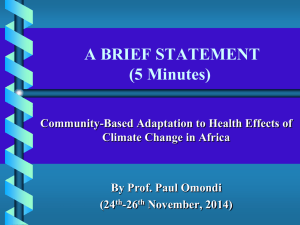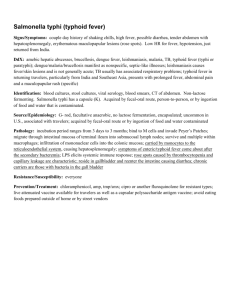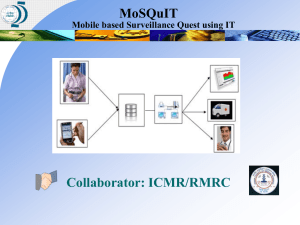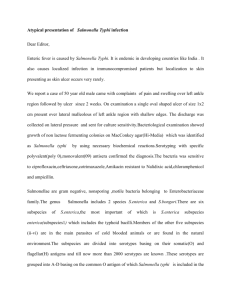A proposal for a consortium to study invasive Salmonella infections
advertisement
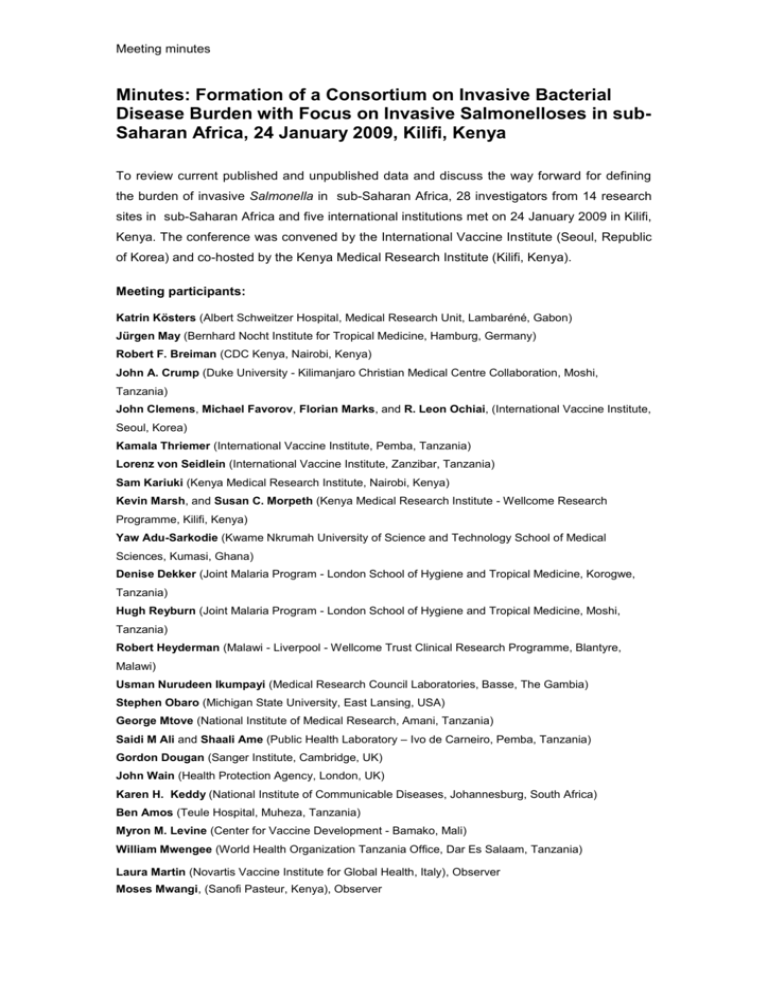
Meeting minutes Minutes: Formation of a Consortium on Invasive Bacterial Disease Burden with Focus on Invasive Salmonelloses in subSaharan Africa, 24 January 2009, Kilifi, Kenya To review current published and unpublished data and discuss the way forward for defining the burden of invasive Salmonella in sub-Saharan Africa, 28 investigators from 14 research sites in sub-Saharan Africa and five international institutions met on 24 January 2009 in Kilifi, Kenya. The conference was convened by the International Vaccine Institute (Seoul, Republic of Korea) and co-hosted by the Kenya Medical Research Institute (Kilifi, Kenya). Meeting participants: Katrin Kösters (Albert Schweitzer Hospital, Medical Research Unit, Lambaréné, Gabon) Jürgen May (Bernhard Nocht Institute for Tropical Medicine, Hamburg, Germany) Robert F. Breiman (CDC Kenya, Nairobi, Kenya) John A. Crump (Duke University - Kilimanjaro Christian Medical Centre Collaboration, Moshi, Tanzania) John Clemens, Michael Favorov, Florian Marks, and R. Leon Ochiai, (International Vaccine Institute, Seoul, Korea) Kamala Thriemer (International Vaccine Institute, Pemba, Tanzania) Lorenz von Seidlein (International Vaccine Institute, Zanzibar, Tanzania) Sam Kariuki (Kenya Medical Research Institute, Nairobi, Kenya) Kevin Marsh, and Susan C. Morpeth (Kenya Medical Research Institute - Wellcome Research Programme, Kilifi, Kenya) Yaw Adu-Sarkodie (Kwame Nkrumah University of Science and Technology School of Medical Sciences, Kumasi, Ghana) Denise Dekker (Joint Malaria Program - London School of Hygiene and Tropical Medicine, Korogwe, Tanzania) Hugh Reyburn (Joint Malaria Program - London School of Hygiene and Tropical Medicine, Moshi, Tanzania) Robert Heyderman (Malawi - Liverpool - Wellcome Trust Clinical Research Programme, Blantyre, Malawi) Usman Nurudeen Ikumpayi (Medical Research Council Laboratories, Basse, The Gambia) Stephen Obaro (Michigan State University, East Lansing, USA) George Mtove (National Institute of Medical Research, Amani, Tanzania) Saidi M Ali and Shaali Ame (Public Health Laboratory – Ivo de Carneiro, Pemba, Tanzania) Gordon Dougan (Sanger Institute, Cambridge, UK) John Wain (Health Protection Agency, London, UK) Karen H. Keddy (National Institute of Communicable Diseases, Johannesburg, South Africa) Ben Amos (Teule Hospital, Muheza, Tanzania) Myron M. Levine (Center for Vaccine Development - Bamako, Mali) William Mwengee (World Health Organization Tanzania Office, Dar Es Salaam, Tanzania) Laura Martin (Novartis Vaccine Institute for Global Health, Italy), Observer Moses Mwangi, (Sanofi Pasteur, Kenya), Observer Meeting minutes Agenda: Opening speech – Dr. Sam Kariuki Presentation on IVI – Dr. John Clemens Introduction and presentation of sites Ghana – Dr. Yaw Adu-Sarkodie Nigeria – Dr. Stephen Obaro Gabon – Dr. Katrin Kösters Tanzania (Muheza) – Dr. George Mtove Tanzania (Moshi) – Dr. John Crump Zanzibar (Pemba) – Dr. Shaali Ame / Dr. Kamala Thriemer Kenya (Nairobi) – Dr. Robert Breiman Malawi – Dr. Robert Heyderman South Africa – Dr. Karen Keddy Mali – Dr. Myron Levine Kenya (Kilifi) – Prof. Dr. Kevin Marsh Presentation – Dr. Gordon Dougan Genetic variability of Salmonella enterica and challenges in diagnostics for typhoid fever Presentation – Mr. Leon Ochiai The DOMI experience: Lessons learned from a five-country, standardized disease burden study of typhoid in Asia Presentation – Dr. Lorenz von Seidlein Presentation of a draft consortium protocol followed by discussion Meeting resolutions – Dr. John Clemens / Dr. Sam Kariuki A) Opening speech by Dr. Sam Kariuki / KEMRI Dr. Sam Kariuki presented data on several typhoid fever (TF) outbreaks in Kenya and data on antimicrobial drug resistance of isolates. Prior to 1992, the majority of bacterial isolates were susceptible to antimicrobial compounds; after 1992, resistance spread quickly, thereby rendering >80% of S. Typhi strains resistant against mainline antimicrobials. In addition, Dr. Kariuki described problems in diagnosis, as appropriate isolation of S. Typhi from blood, bone marrow or CSF is expensive and not widely available in Kenya. Outbreaks can be expected in the future since health services cannot be delivered to resource-poor settings where the population is increasing. He concluded that effective, standardized surveillance is crucial at a national level and that vaccinations might become a viable option in sub-Saharan countries due to increasing levels of MDR. B) Presentation of the IVI by Dr. John Clemens / IVI Dr. Clemens described the IVI, which is a center of excellence in vaccine sciences. During his presentation, he presented the IVI’s Diseases of the Most Impoverished (DOMI) Program and its multi-country program on typhoid fever, which was based on standardized surveillance methods in participating sites in Asia. He also presented data from African sites with which IVI is currently collaborating, highlighting the need for standardized surveillance in sub-Saharan countries. Meeting minutes C) Presentation of Ghana site by Dr. Yaw Adu-Sarkodie / KCCR Dr. Yaw Adu-Sarkodie described the study site in Agogo, Ghana, which is a rural village 80 km northeast of Kumasi, the second largest metropolitan area in the country. The study hospital is the Agogo Presbyterian Hospital, the oldest mission hospital in Ghana with a catchment population of about 70,000 people. Passive, hospital-based surveillance for febrile illnesses commenced in 2006, and all patients with acute fever or history of fever (for the past three days) who required hospitalization were enrolled in the surveillance study. Malaria slides and blood cultures were prepared for disease diagnosis. Initial results revealed high incidences of S. Typhi (around 205/100,000 among 4-5 year olds) and of Non-Typhoid Salmonella (NTS) (around 1,650/100,000 among 1-2 year olds). MDR strains of S. Typhi and NTS were found although ceftriaxone and ciprofloxacin remain effective. D) Presentation of Nigeria site by Dr. Stephen Obaro / Michigan State University Dr. Stephen Obaro described the CABSYNC study (Community-Acquired Bacteraemic Syndrome in Young Nigerian Children) that is on-going. Study sites include the National Hospital, Zankli Medical Center and Nyanya Health Center, which cover parts of rural areas and parts of urban areas. The study will utilize an automated blood culture system and is aimed at defining etiology of febrile illnesses in children between 2 months to 5 years of age. Participants are evaluated for malaria with a blood smear, blood culture and HIV-testing. This study commenced enrolment in November ’08. A brief summary of another study which has just concluded from Ibadan, Southwestern Nigeria was also presented. This study utilized traditional culture system and 1,210 children were enrolled with 27 children diagnosed with invasive disease from Salmonella species. E) Presentation of Gabon site by Dr. Katrin Kösters / Albert Schweitzer Hospital Dr. Kösters described the rural study site in Lambaréné, Gabon. The Albert Schweitzer Hospital (ASH) was founded in 1913 and is run by the International Albert Schweitzer Foundation in cooperation with the Ministry of Health of Gabon. It has a catchment population of 50,000; in 2007, 5500 patients were admitted and 24,500 patients were seen at outpatient clinics. The adjacent Medical Research Unit (MRU), which is run by the University of Tübingen, Germany, works particularly on Plasmodium falciparum malaria, tuberculosis and schistosomiasis, and more recently, also on bacteria. The bacteriological lab was set-up in 2008. Among the 400 specimens from all age groups that have been blood-cultured to date, one S. Typhi specimen and three NTS specimens, all fully susceptible, were isolated. F) Presentation of Muheza, Tanzania site by Dr. George Mtove / NIMR Dr. George Mtove presented data from the Teule Hospital in Muheza, Tanzania. Children between 2 months and 14 years of age were enrolled and the hospital serves a rural catchment area of 277,000 people. Among 5,031 enrolled children, 23 S. Typhi cases and 205 NTS cases were detected. The first 161 NTS isolates were sero-typed and the following was found: 137 (85%) S. Typhimurium, 11 (7%) S. Enteritidis, 6 (4%) S. Dublin, 1 (0,7%) S. Hvittingfoss, and 1 (0.7%) S. Heidelberg. In addition, risk factors were presented; recent malaria infection and age <5 years were associated with increased risk for NTS infection. G) Presentation of Moshi, Tanzania site by Dr. John Crump / KCMC Dr. Crump presented data from the site in Moshi, which were obtained from the Kilimanjaro Christian Medical Centre and Mawenzi Regional Hospital. Fever surveillance began at this rural site in July 2006 and patients older than two months of age admitted to the hospital in Moshi with acute fever or history of fever were enrolled in the study. Blood for malaria slides and blood culture were obtained from patients, and within one year, 411 adults and adolescents were enrolled, among which 10.5% died. In 19.3% of cases, pathogens could be isolated from blood culture. Among these, 36.1% were S. Typhi and only 1.4% were NTS, which is in sharp contrast to data presented from the Muheza, Tanzania, site 300 kilometers to the east. 480 children were enrolled during a similar time period, among which 7.5% died. Meeting minutes In only 4% of cases, pathogens could be isolated through blood culture. The major pathogen was Streptococcus pneumoniae (33.3%), followed by S. Typhi (27.8%). No NTS was isolated. Additional data on antimicrobial resistance was presented, with the majority of S. Typhi strains being resistant to ampicillin, chloramphenicol, sulfamethoxazole and trimethoprim but still susceptible to nalidixic acid and ceftriaxone. H) Presentation of Pemba, Tanzania site by Dr. Kamala Thriemer / IVI Dr. Thriemer presented the site at Pemba, a rural island on the coast of Tanzania. Surveillance has been initiated at the Chake-Chake Hospital and all patients older than two months of age with acute or reported fever are enrolled. Blood samples are obtained from patients for blood culture and malaria slides. To date, 1,949 patients have been screened and 146 patients have been enrolled. Ten cultures yielded bacterial growth, which included one S. Typhi isolate and one NTS isolate. Additional hospitals will be included in the surveillance in the forthcoming months. I) Presentation of Nairobi, Kenya site by Dr. Robert Breiman / CDC-KEMRI Dr. Breiman presented a population-based surveillance approach for 55,000 people in two sites (rural – 25,000 and urban (Kibera) – 30,000). Every household was visited every two weeks to detect pneumonia, diarrhea, fever, and jaundice. Obtained blood specimens were used for blood culture, stored serum and malaria slides. In Kibera, 81 S. Typhi cases could be detected in cultures from 1,615 blood cultures, with the majority of cases in the age group 5-9 years, yielding a crude incidence of 537/100,000 in this age group. In addition, Dr Breiman presented an approach to calculate underreporting of S. Typhi using multipliers. J) Presentation of Malawi site by Dr. Robert Heyderman / MLW Dr. Heyderman described the research on febrile diseases conducted in Blantyre, Malawi. The mortality among children under five years in this setting is high (134/1000), and in 2007 1,548 positive blood cultures were detected from 4,275 processed pediatric blood samples (including contaminants). Among these, there were 266 Salmonella isolates. 4,919 blood cultures of adult patients were processed and yielded 1,099 positive cultures (including contaminants). 311 Salmonella isolates were found. In addition, Dr Heyderman presented data on epidemics of invasive NTS serovars in Malawi. K) Presentation of South African site by Dr. Karen Keddy / NIED Dr Keddy presented data from South Africa, where national laboratory-based surveillance for nine bacterial and fungal diseases is being conducted in 170 clinical microbiology laboratories. All patients are included in the surveillance program. Annually, between 1,400 and 1,600 Salmonella isolates are collected, and the majority of isolates are S. typhimurium (ca. 60%). S. Typhi isolates are about 15% of isolates. L) Presentation of Mali site by Dr. Myron Levine / CVD – Mali Dr. Levine showed data from Mali, a land-locked country with a high infant mortality rate of >135/1,000. Surveillance is conducted at the Hopital Gabriel Touré (HGT) and all children (015 years) with fever >39.0°C, and signs and symptoms suggestive of invasive bacterial disease are enrolled. They identified 519 NTS isolates, among which 365 were from inpatients, and 135 cases of S. Typhi were diagnosed. In addition, case fatality rates (CFR) of NTS and of S. Typhi in in-patients were presented, with the highest rates in highest in children <12 months old (29% and 37,5%, respectively). Dr. Levine presented data on drug susceptibility to commonly used antimicrobials, and indicated the existence of high resistance in S. enteritidis and typhimurium isolates against ampicillin, choramphenicol, trimethoprimsulfamethoxazole but almost no resistance in S. Typhi isolates against these compounds. Meeting minutes M) Presentation of Kilifi, Kenya site by Prof. Dr. Kevin Marsh / KEMRI Surveillance for bacteremia began in 1998, and more than 50,000 patients have been enrolled in the course of the study. No S. Typhi isolates could be detected during the study. The incidences of NTS infection were about 170/100,000 in under two year olds and 88/100,000 in under five year olds. The majority of NTS serotypes were S. Typhimurium (52%) and S. Enteritidis (38%). In addition, Prof. Marsh demonstrated a decline in NTS, which was in parallel with a decline in P. falciparum malaria incidence. N) Presentation on genetic variability of Salmonella isolates by Dr. Gordon Dougan / Sanger Institute Dr. Dougan described the advantages of a genome-wide scan of Salmonella isolates. This would provide a unique identification of various strains and enable researchers to assess not only the geographic origin but also progenitor strains of particular haplotypes. A phylogenetic tree of all haplotypes could be constructed as each lineage is composed of a different genetic combination. O) The DOMI experience by Mr. Leon Ochiai / IVI Mr. Leon Ochiai described the DOMI (Diseases of the Most Impoverished) Program conducted in Asia. The program was a multi-centric, multi-disciplinary program coordinated by the International Vaccine Institute. At the initiation of the DOMI Program, limited population-based data on typhoid was available and existing incidence data did not allow for cross-country comparisons, and thus a standardized study design was implemented to obtain comprehensive and comparable population-based data. The program also conducted standardized policymaker surveys, economic, and socio-behavioral studies. Summaries of the cross-country study results on incidence, antibiotics resistance, cost-of-illness, and costeffectiveness studies were presented. It was suggested that multi-centric, multi-disciplinary studies are critical in assessing burden of invasive salmonelloses in Africa, and that population-based data can be enhanced by inclusion of socio-behavioral and economic studies for informing global policy on intervention for these diseases. Mr. Ochiai concluded that the DOMI Program illustrated the feasibility of such multi-centric, multi-disciplinary approach. P) Presentation of draft consortium protocol for discussion by Dr. Lorenz von Seidlein / IVI Data derived from the various presentations of meeting participants were difficult to compare, underlining the need for standardized febrile illness surveillance. Dr. Lorenz von Seidlein presented a draft protocol for the conduct of standardized surveillance in participating countries. The details and results of the discussion are in Appendix 1. Q) Meeting resolutions by Dr. Sam Kariuki / Dr. John Clemens The conference ended with the conclusion that existing epidemiological information on invasive salmonelloses in sub-Saharan Africa is still fragmentary, and hindered by heterogeneous study methodology. It was agreed among the participants that there is an urgent need to collect better data on invasive Salmonella infections in sub-Saharan Africa. Collection of standardized, multi-country, multi-disciplinary data on the burden, risk factors, and costs of these infections will be essential to help develop a consensus at the regional, national, and international levels in establishing appropriate control measures. The optimal method is to utilize existing fever surveillance studies but to standardize epidemiologic and laboratory procedures across sites. Additionally, vaccine demonstration projects should be considered for sites with known high burden of typhoid fever such as the urban slums of Nairobi, Kenya. Dr. Sam Kariuki and Dr. John Clemens presented the meeting resolutions. The participants agreed upon the creation of an African salmonelloses initiative for epidemiological research and advocacy. This new consortium will mount much-needed standardized multi-country Meeting minutes studies to yield evidence about the disease burden of typhoid and other invasive salmonelloses and the effectiveness of typhoid vaccines in sub-Saharan Africa, which can ultimately lead to the systematic deployment of interventions against invasive Salmonella infections. It was discussed that these studies could also generate research and research training opportunities for young African scientists. The IVI’s DOMI Program, which was described earlier, could serve as a blueprint for the set-up and conduct of such concerted collaborative action. The IVI was chosen to act as the secretariat of the consortium and to coordinate consortium activities, as well as bi-annual consortium meetings. The steering group for the consortium is yet to be determined. In addition, the group agreed upon the development of a Letter of Intent that will be reviewed and approved by consortium members, and will be jointly submitted to the Bill and Melinda Gates Foundation for funding. Appendix 1 Results of the technical discussion of the draft protocol presented by Dr. Lorenz von Seidlein (IVI) Site selection (see table below for sites currently planning to participate) o Looking at the map at early stage to find out “gaps” Consider approaching Francophone countries Consider looking at other networks (e.g. RTSS, PneumoNET, etc.; since they will have the infrastructure already) Standard protocol across sites • Both epidemiologic and laboratory • To compare and contrast results (differences across sites may not be ascribed to differences in procedures) • To combine data for analysis for robust findings Study design - Overview • Prospective cohort study in a standardized fashion • Enroll febrile children and adults – Standardized clinical and epidemiologic information will be collected – Specimens will be obtained for a standard aerobic blood culture, a malaria slide, and an HIV antibody test – Acute sera will be archived – In-patient discharge outcome will be documented – Follow-up for sequelae and mortality after discharge – Case-control studies of risk factors • Private and public costs of invasive Salmonella and other bacterial infections • Social science studies on perceptions and health seeking behaviour for febrile illnesses • Studies of policy makers views of Salmonella and Salmonella control • Planning of interventions to control Salmonella in Africa • Population based study will be robust, but will depend on the funding and site characteristics – Catchment area should be well-defined - for calculation of incidence data – Different approaches by site possible – If hospital-based, mapping of patients and data from National Mapping Service to get good catchment areas will be important. Study population • Enroll individuals from a catchment area with: – All ages? – Neonates should be included since they are the ones at risk from NTS • Drawing blood from neonates may require skilled technicians, but it should not be discouraged since it provides important information for clinical care • One possibility would be the inclusion of neonates after initial investigational procedures have been established – Fever • History of fever of 3 days or more? • Definition fever: could be history, could be 37.5C axillary? • We should not only look for febrile cases, especially for infants – HIV testing according to regulation of each participating country – -> Potential ethical issue: HIV counselling & treatment? – -> There has to be resources to treat HIV if detected – -> sometimes IRB can ask for higher standard of treatment in a research scenario Methods • Standardized data will be important, but most sites may have their own data collection system already Appendix 1 Consortium should focus on “data extraction” system instead of making a new case report form Provide clinical assessment and treatment according to WHO/national guidelines Obtain written informed consent Assign a unique surveillance code number to identify all documents and laboratory specimens (i.e., no personal identifiers like names) Complete a standard case report form For discussion: Obtain elemental clinical data on admission to develop of scales for diagnosis and prognosis? • • • • • • o • • • • • • • Scoring system based on a set of definitions on clinical scales can be applied to determine its validity Need to develop core-agreed (“consortium-agreed”) set of definitions of clinical scales Such was often tested for mortality, but not so much for diagnosis – may be difficult to come to a set of definitions, but may worth trying Point-of-care testing, as indicated • RDT for P. falciparum • Heamoglobin • Blood glucose Standard aerobic blood culture (Bactalert / BacTec) • 5–10 ml of blood from adults inoculated into culture bottles • 1–3 ml of blood from infants and children inoculated into paediatric culture bottles Malaria slide (thin and thick films) – single read according to standard methods HIV testing • 2 ELISA tests • PCR for discordant results and for specimens from those <18 months of age • Viral load / CD4 count Sera for archiving Capture in-hospital outcome Follow-up at 4 weeks (from initial presentation) for: • Treatment compliance • Disability • Carriage? o • Follow-up of patients may depend on the site setting – some sites may not have access to individual household to follow up This could be applicable to some sites, but not to all sites Follow-up after 4 weeks (from initial presentation) for treatment compliance and disability For those places with capability to do so (ones with DSS), looking into carriage after 12 months is essential For all sites (regardless of the capacity to do repeated follow up of cases), at least mortality survey should be done Long-term follow-up to assess disease outcomes: 3, 6, 12 months? Laboratory capacity • Incubating and monitoring blood culture bottles according to standardized methods (BacTec or BactAlert), For culture, BACTEC or BacTAlert should be acceptable as they give same results (John Crump) • Isolating Salmonella and other pathogenic bacteria from blood • Identifying common bacteria to the species level • Antimicrobial resistance profile • Archiving bacterial isolates • Reading malaria films • HIV testing • Processing and storing sera at -80ºC, • Shipping samples to reference laboratories Appendix 1 • • • • • • Blood volume – more is always better, but that is not feasible all the time • Measure the culture bottle before and after to record the actual volume taken Put centralized QC system in place Some sites may want to look into more than salmonella… • The consortium protocol will be a skeleton specifically focusing on salmonelloses and possibly other aerobic organism, and each site could add on to it what they are doing or interested in doing Provision of training is essential Reference lab can be more than one Put in consideration from the initial stage the transfer of shipments • Usually with the “WHO reference lab” as the addressee, transportation of the specimens is not a problem Reference laboratories – Receive isolates from participating laboratories – Providing QC/QA and training – Antimicrobial susceptibility testing to a recognized international standard (e.g., Clinical Laboratory Standards Institute) – Serotyping Salmonella – HIV PCR / viral load – Regional reference laboratories could be established – Selection of reference laboratories should be fair and transparent – Microbiological task force must work out problems for proficiency testing Collaborating laboratories • Receive samples from participating laboratories • Evaluating diagnostic tests (e.g., new RDTs) • Conducting basic science research relevant to vaccine development Include microbiology and genotyping issues (Sanger, Bernhard Nocht Institute for Tropical Medicine) Nested studies • Case-control studies – To assess risk factors (demographic, geographic, water - sanitation, socioeconomic characteristics, and animal husbandry) for S. Typhi, NTS, and other bacterial bloodstream infections, – Method: sex and age-group matched • General comment – many studies have already been conducted and some of these nested studies should be optional by site Though it is possible to give freedoms to each site, but not insisting on standardized model will lose attractiveness to donors Case-control study can have two aims: o 1) look into co-morbidity, and o 2) source of infection Some sites have already done their risk assessment – they may look into the forms and consider use of the same one for other sites Considering investigations in veterinary source might be worth Economic and socio-behavioral studies have been carried out in many places, but often not interpretable or out of context It is essential to have appropriate specialist leading these studies and an attractive proposal for the donor Economic studies – Private costs-of-illness • sample by age-group (infants/children/adults) • inpatient vs. outpatient • Interview on consultation/admission and during the 4-week follow-up – Public costs – including capital and running costs Appendix 1 • Socio-behavioural science studies – On perceptions of disease, health seeking behaviour for febrile illnesses and demand for control/intervention: • Qualitative rapid assessments of 5-10 community leaders and 5-10 health care workers (convenience sampling) • Quantitative survey of community members (existing census data used to randomly select 300 to 400 adult community members) • HUS questions also included in CRF • Vaccine demonstration projects – To demonstrate mass typhoid vaccination in known high disease burden sites – To assess vaccine’s impact in reducing typhoid fever – To assess feasibility of mass typhoid vaccination • Interview policymakers on their views of bacterial infections specifically Salmonella (in an era of malaria elimination, potential control of Pneumococcal and H.flu infections through vaccination). Plan • • • • Identify potential donors Submit LOI Develop full proposal Once funded, implementation will occur in several phases: Implementation phases • Phase I: Site establishment – Develop standardized protocols for all studies – Develop and standardize laboratory methods, train clinical research staff. • Phase II: Surveillance – Sites will establish and sustain surveillance for invasive Salmonella and other bacterial infections. • Phase III: Reference laboratories – Reference laboratories will receive samples for antimicrobial susceptibility testing, Salmonella serotyping, evaluating diagnostic tests, and conducting basic science research relevant to NTS vaccine development. • Phase IV: Special studies. Sites will conduct nested special studies. • Phase V: Vaccine demonstration project or pilot introduction should be considered as final phase for sites with enough data on typhoid Discussion Potential donors o The consortium will aim to approach Gates/Wellcome Organization o Coordinating role will be by the IVI (Secretariat/management role) o Governance should be by selected individuals/institutions of the consortium possibly in rotating fashion Appendix 2 Table 1: Summary of presentation of participating sites and remarks during discussion Location Type location Type surveillance Inclusion criteria (fever etc.) Age group Lab tests Remarks Agogo (Ghana) Rural Hospital-based, passive History (72h) or acute fever and severe disease >2 months Blood culture (BC), malaria - high proportion of culture-positive (about 20%) - Sensitivity testing for Nalidixic acid not done Kilifi (Kenya) Rural Hospital-based, passive All pediatric admissions Pediatric populations BC, HIV, malaria - Malaria and NTS declining along the Kenyan coast (parasitemia rates proportional to NTS rates) Bamako (Mali) Urban and Hospital-based, rural passive 0-15y BC, malaria 71% of admission presumed infection. 50% of them malaria. In 6 years (2002-2008) 519 NTS (365 from inpatients) cases and 135 S. Typhi cases. 84.4% from Bamako residents Lambaréné (Gabon) Rural Hospital-based, passive Muheza (Tanzania) Rural Hospital-based, passive Fever >39°C, Clinical syndrome suggestive of invasive bacterial disease Any febrile illness suspicious of invasive bacterial infection History (72h) or acute fever and severe disease Moshi (Tanzania) Urban and rural Hospital-based, passive Nairobi (Kenya) Urban All age-groups BC, HIV, (at physicians malaria request) - S. Typhi and NTS isolated from children over 9 years adult population 2 months to 14 BC, HIV, years malaria - Unrelated and sporadic occurrence of S. Typhi Pediatric: History > 2 months (72h) or acute fever and severe disease Adult: >38.0°C (oral) Active, population-based >38.5C and/or all (defined denominator) patients suspected with household based and of severe clinic based surveillance pneumonia BC, HIV, malaria - no NTS found among children, 1 NTS in adult group - high percentage of S. Typhi infections (36 S. Typhi in 90 positive cultures) - no Nalidixic acid resistance found BC, malaria, HIV, NP/OP swabs on patients meeting pneumonia or influenza - HUS showed 39% of fever cases and 47% of diarrhea cases seeking care at pharmacies - High incidence of typhoid (400/100,000 py) among 5-9 yo - NTS and S. Typhi much higher in urban population - 2 strains resistant to ciprofloxacin, 8 strains resistant to Nalidixic acid Appendix 2 criteria Pemba (Zanzibar) Rural Hospital-based Passive 3 days or more > 2 months blood culture, HIV, malaria Urban and Hospital based Rural Passive Less than 14days 2-59mo (Nigeria) Blood culture Malaria, HIV, APR 38% national immunization coverage, some states < 10%. High rates of non-prescribed antibiotics use. Blantyre (Malawi) Urban & Hospital-based Rural Sites Passive Any febrile illness Few neonates; (not Malaria)/ largely >2mths suspicious of invasive bacterial infection 266 Salmonella, 95% S. enterica. Two NTS epidemics (1 from enteritidis, Dec 98 – Dec 02), drug resistant, 1 from typhimurium (end of 02), sensitive (S. Africa) Countrywide N/A – all invasive/noninvasive Salmonella blood culture, CSF, HIV, malaria, radiology, sputum smear & culture Specimen culture Active laboratory surveillance All ages Active laboratory-based system. Surveillance officers at 10 sites around the country collect clinical information. About 170 labs countrywide submit data (CRF and isolates) to the NICD. Predominantly S. typhimurium, some enteritidis, some S. Typhi. Majority of S. cases are HIV+; Patient outcome: Death rate very high, 30%
